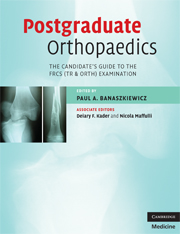Book contents
- Frontmatter
- Contents
- List of contributors
- Foreword by Mr Peter Gibson
- Preface
- Glossary
- Section 1 The FRCS (Tr & Orth) examination
- Section 2 The written paper
- Section 3 The clininicals
- 3 The short cases
- 4 Short case list
- 5 The long cases
- 6 Long case list
- 7 Hand and wrist clinical cases
- 8 Shoulder and elbow clinical cases
- 9 Spine clinical cases
- 10 Hip clinical cases
- 11 Knee clinical cases
- 12 Foot and ankle clinical cases
- 13 Paediatric clinical cases
- Section 4 Adult elective orthopaedics oral
- Section 5 The hand oral
- Section 6 The paediatric oral
- Section 7 The trauma oral
- Section 8 The basic science oral
- Section 9 Miscellaneous topics
- Index
- References
13 - Paediatric clinical cases
from Section 3 - The clininicals
Published online by Cambridge University Press: 22 August 2009
- Frontmatter
- Contents
- List of contributors
- Foreword by Mr Peter Gibson
- Preface
- Glossary
- Section 1 The FRCS (Tr & Orth) examination
- Section 2 The written paper
- Section 3 The clininicals
- 3 The short cases
- 4 Short case list
- 5 The long cases
- 6 Long case list
- 7 Hand and wrist clinical cases
- 8 Shoulder and elbow clinical cases
- 9 Spine clinical cases
- 10 Hip clinical cases
- 11 Knee clinical cases
- 12 Foot and ankle clinical cases
- 13 Paediatric clinical cases
- Section 4 Adult elective orthopaedics oral
- Section 5 The hand oral
- Section 6 The paediatric oral
- Section 7 The trauma oral
- Section 8 The basic science oral
- Section 9 Miscellaneous topics
- Index
- References
Summary
Cerebral palsy
May come up as a long case; it is unlikely as a short case. If unlucky, you will be shown a video of the gait of a cerebral palsy patient near the end of the paediatric oral and asked to describe it.
Try to minimize moving backwards and forwards from the couch to reduce distress to the patient and look as though you have a system:
General
Standing
Walking
Supine on couch
Lateral position on couch
Prone on couch
General
Comment on the presence of wheelchairs, walking aids, gastrostomies, nappies, braces and orthotics, e.g. KAFOs, AFOs, spinal braces.
Look at pattern of involvement
Monoplegic
Hemiplegic
Diplegic (lower limbs affected more than upper)
Paraplegic (arms not affected)
Quadriplegic
Total body
Cerebral palsy can also be classified according to type:
Spastic (60%)
Athetoid (20%)
Ataxic
Hemiballismic
Hypotonic
Combination
Standing
Ask whether the patient is able to stand first
Look from behind, from the side and from the front for obvious deformities, e.g. obvious joint contractures, adduction of the hip, shortened leg, equinus and varus or valgus feet
Note stability when the child is gently pushed forwards, backwards and from side to side (predicts the need for support when walking)
Spine: is there a fixed scoliosis? Adams' test (bending over)
Pelvic obliquity: if there seems to be a limb length discrepancy, use blocks to even up the pelvis and look from behind
Walking
Look and describe walking in three planes
Sagittal: from the side
Transverse: from the front
Coronal: imagine looking from above
- Type
- Chapter
- Information
- Postgraduate OrthopaedicsThe Candidate's Guide to the FRCS (TR & Orth) Examination, pp. 126 - 132Publisher: Cambridge University PressPrint publication year: 2008



